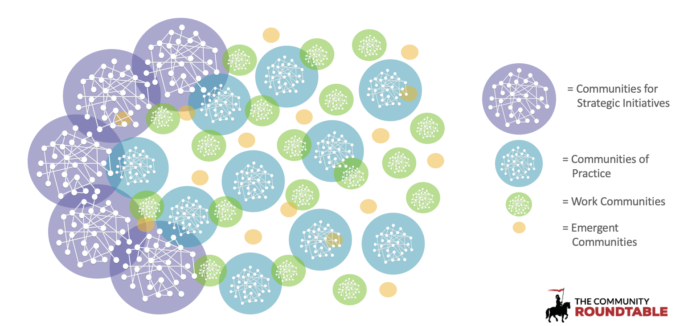Digital Transformation is a Given
All executives know that the world of business and work is changing rapidly as digital channels and technologies become more integrated into everything we do. From the small bakery that posts evocative pictures on Instagram to the multi-national organization that needs to align more employees than exist in small countries. We are all facing a world that is more interconnected than ever – but with the skills, perspectives, beliefs, and social norms that we developed in an educational and work environment built for the last century.
We feel the stress of that dichotomy, whether we have accepted that we are unprepared for the world we now live in or not. There is also a raft of analysts, experts, and self-proclaimed thought leaders that have a vision for what the Future of Work looks like and collectively, we are getting a better picture of what that looks like as more case studies emerge at the edges.
Where Do We Start?
While we need to change ourselves and our organizations, I see a lot of avoidance in making any decisions at all – or stalling by having one more expert come in share their perspective, hoping it might be the magic bullet. From my
Which thread do we pull first? Do we implement the technology first and hope for the best? Do we try and shift the culture? Do we change leadership?
These ALL need to be addressed and my take is that there is no sequential process that will work. The technology, the culture, the governance structure, our measurement models, and the leadership approach are all inter-dependent, making digital transformation a giant hairball.
Communities Can Co-Create the Future, Incrementally
Using communities as a strategic approach is one of the best ways to lead in a complex environment, where there are no right answers only a series of options. In effect, it takes the risk out of making the wrong decision off the table and allow the future to emerge in an efficient and addressable way.
A community approach works because:
- You don’t need to have an answer. The problems and opportunities are what bring people together, energize, and engage them.
- Participation in the solutions drives commitment and buy-in.
- Communities naturally bring people along and compel them to change as different solutions emerge – reducing resistance and rejection to change.
- You can say yes to everyone – anyone interested in the problem or opportunity can contribute, without it taxing the system.
- You discover the risks and opportunities that you could never have seen – all the things you didn’t know you didn’t know.
Structuring an Ecosystem for Today – and Tomorrow
The way our clients are doing this is to architect ecosystems that accommodate both the culture and structure of their current organization while also encouraging and enabling emergent structures. These ecosystem strategies typically include multiple types of communities:
- Organizationally sponsored and managed communities that address the current organizational priorities and structures. These communities include those focused on a current strategic priority (AI, for example) or aligned with current operational structure (a customer support community).
- Organizationally supported communities, managed by those who have taken on the initiative to manage them. These communities are typically formed around innovation – tackling new problems and opportunities that someone sees at the edge and wants to pursue. The organization provides support in the form of tools/infrastructure, training, measurement, and advise but does not formally assign staff to them.
- Emergent communities started by individuals who want to experiment. These communities have access to infrastructure but need to ‘prove’ themselves before more resources or support will be provided.

This model provides avenues for current organizational priorities to dominate in the near-term, which helps everyone understand the purpose and direction of the communities while getting comfortable with the new engagement dynamic. Critically, however, it also allows for a more emergent approach to grow in influence over time, shifting the balance of power as people become comfortable with the new model. This allows organizations to explore who wants to take leadership initiative and what topics, problems, or challenges gain traction with their stakeholders. As those communities grow in influence, they will get wrapped up into core organizational priorities.
This structure allows the current, top-down structure to blend over time with an emergent bottom-up structure – while avoiding a hard flip to a ‘change’ switch that would be very expensive and is more likely to fail. It also allows the organization to address incremental issues as they arise instead of planning for every plausible scenario centrally before initiating any change.
How to Start
The first step to implementing this approach is to develop an ecosystem strategy – understanding the participants, their motivations, and imaging what each type of community will look like in terms of resources required and outputs expected.
The second step is to build a community team prepared to both manage some communities and support many more as a center of excellence – developing a services model that differentiates between each type of community and defining what resources and requirements are available to each.
The third step is to resource this team appropriately. Currently, the majority of community teams are acting like centers of excellence but only 8% are officially tasked and resourced to perform this role.
Interested in learning more? Please reach out – this is the majority of the advisory work we have been doing with clients over the last 18-24 months.
